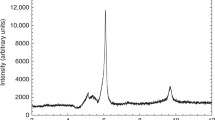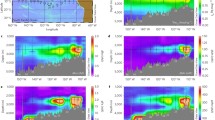Abstract
Phosphate distributions in oxic–anoxic ocean basins are related to distributions of total oxygen consumed (mainly from free oxygen, nitrate and sulphate) in the decomposition of organic matter1,2. Data from the Black Sea show, however, that phosphate concentrations immediately above and below the redox front are considerably lower and higher, respectively, than would be predicted from such stoichiometric models. This implies extra sinks and/or sources of phosphate and/or total oxygen not associated with organic decomposition. Here, I present two physical–biogeochemical interactions that result in phosphate sinks and sources with the structure needed to explain the observed phosphate anomalies. A phosphate pump based on iron can account for up to 40% of the required sink–source strength. The rest may be caused by a phosphate shuttle based on manganese.
Similar content being viewed by others
References
Richards, F. A. in Proc. 2nd Int. Wat. Pollut. Res. Conf. Tokyo 1964, 215–243 (Pergamon, Oxford, 1965).
Richards, F. A. in Chemical Oceanography Vol. 1, (eds Riley, J. P. & Skirrow, G.) 611–645 (Academic, London, 1965).
Brewer, P. G. Woods Hole Oceanogr. Inst. Tech. Rep. Ref. no. 71-65 (1971).
Spencer, D. W. & Brewer, P. G. J. geophys. Res. 76, 5877–5892 (1971).
Cox, M. G. J. Inst. Math. Appl. 10, 134–149 (1972).
Fonselius, S. H. in The Black Sea—Geology, Chemistry and Biology (eds Degens, E. T. & Ross, D. A.) 144–150 (American Association of Petroleum Geologists, Tulsa, 1984).
Brewer, P. G. & Murray, J. W. Deep-Sea Res. 29, 803–818 (1973).
Shaffer, G. & Rönner, U. Deep-Sea Res. 31, 197–220 (1984).
Grasshof, K. in Chemical Oceanography Vol. 2 (eds Riley, J. P. & Skirrow, G.) 455–597 (Academic, London, 1975).
Einsele, W. Archiv. Hydrobiol. Plankton 33, 361–387 (1938).
Krom, M. D. & Berner, R. A. Geochim. cosmochim. Acta 45, 207–216 (1981).
Deuser, W. G. in The Black Sea—Geology, Chemistry, and Biology (eds Degens, E. T. & Ross, D. A.) 133–136 (American Association of Petroleum Geologists, Tulsa, 1974).
Merz, A. & Möller, L. Veröff. Inst. Meeresforsch. Berlin. Neue Folge A18 (1928).
Shaffer, G. J. Phys. Oceanogr. 9, 847–855 (1979).
Walin, G. Tellus 29, 128–136 (1977).
Csanady, G. T. in Circulation in the Coastal Ocean (Reidel, Dordrecht, 1982).
Neumann, G. Z. Ges. Erdk. Berl. 3, 92–114 (1944).
Balzer, W., Grasshoff, K., Dieckmann, P., Haardt, H. & Petersohn, U. Oceanol. Acta 6, 337–344 (1983).
Holm, N. Ophelia Suppl. 1, 287–304 (1978).
Li, Y.-H. & Gregory, S. Geochim. cosmochim. Acta 38, 703–714 (1974).
Santschi, P. H., Bower, P., Nyffeler, U. P., Azevedo, A. & Broecker, W. S. Limnol. Oceanogr. 28, 899–912 (1983).
Spencer, D. W., Brewer, P. G. & Sachs, P. L. Geochim. cosmochim. Acta 36, 71–86 (1972).
Author information
Authors and Affiliations
Rights and permissions
About this article
Cite this article
Shaffer, G. Phosphate pumps and shuttles in the Black Sea. Nature 321, 515–517 (1986). https://doi.org/10.1038/321515a0
Received:
Accepted:
Issue Date:
DOI: https://doi.org/10.1038/321515a0
- Springer Nature Limited
This article is cited by
-
Effect of large magnetotactic bacteria with polyphosphate inclusions on the phosphate profile of the suboxic zone in the Black Sea
The ISME Journal (2019)
-
A New Phosphorus Paradigm for the Baltic Proper
AMBIO (2014)
-
Internal loading of phosphorus from sediments of Lake Pontchartrain (Louisiana, USA) with implications for eutrophication
Hydrobiologia (2012)
-
Iron Budget and Its Correlations with Macronutrients in the Inshore Waters of the Aegean Sea
Estuaries and Coasts (2009)





